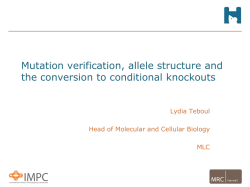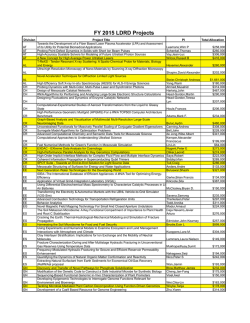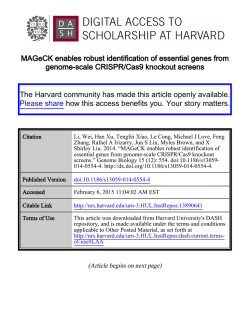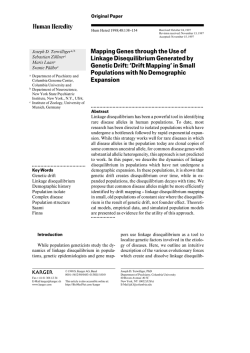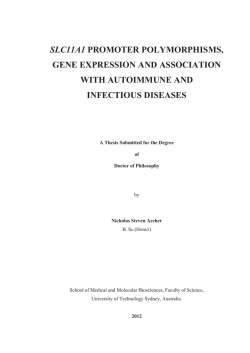
CRISPR-Cas9 - Joffrey Mianne - MRC Harwell
Mouse Network meeting 2015 Mouse genome engineering via CRISPR/Cas9 system Medical Research Council Harwell Mary Lyon Centre Joffrey MIANNÉ CRISPR/Cas9 to engineer the mouse genome • Origin of the CRISPR/Cas9 system: Clustered Regularly Interspaced Short Palindromic Repeats (CRISPR)CRISPR Associated (Cas) (CRISPR/Cas) RNA-based adaptive immune system found in prokaryotes Specific recognition and cleavage of invading nucleic acids Modified to be used as a genome engineering tool PAM Protospacer Adjacent Motif (-NGG) sgRNA Adapted from www.sigmaaldrich.com CRISPR/Cas9 to engineer the mouse genome Non-Homologous End Joining NHEJ Homology Directed Repair HDR Adapted from Shan & al, 2014 • Principle: Cas9 mRNA sgRNA(s) DNA donor template Pronuclear injection in 1 cell stage embryos CRISPR/Cas9 to engineer the mouse genome • Indel(s) / Knock-out(s) Use of Cas9 nuclease + 1 sgRNA Outcomes: small insertions or deletions (NHEJ alleles) which can lead to frameshifts and KO • Point mutation(s) Use of Cas9 nuclease + 1 sgRNA + ssODN donor template Outcomes: NHEJ alleles / HDR alleles WT WT / HDR • Tailored deletion(s) Use of Cas9 nuclease + 2 sgRNAs In-vivo deletions: 30 bp to >50 kbp Outcomes: NHEJ alleles / Alleles with tailored deletion • Gene targeting Use of Cas9 nuclease + 1 or 2 sgRNAs + donor plasmid In-vivo knock-in(s): 1 bp up to >2 kbp Outcomes: NHEJ alleles / Alleles with tailored deletion / HDR alleles Ex: Flox Adapted from Zheng & al, 2014 g1 g2 MRC Harwell CRISPR/Cas9 projects underway • Indel(s) / Knock-Out(s) Alleles with indel(s) found in every project (14/14) carried out. • Point Mutation(s) HDR alleles with point mutation(s) found in 4 projects from 8 performed. Type of project # projects # projects with NHEJ alleles # projects with HDR alleles Indel(s) / Knock-Out 2 2 / Point mutation(s) 8 8 4 Gene targeting “LoxP site(s)” 4 4 0 (before optimisation) Total 14 14 4* * 4 projects were found successful for HDR out of 12 possible • Tailored deletion(s) Not tested in-vivo, but successfully tested in-vitro in 3 different projects with 49, 52 and 521 bp deletions. • Gene targeting Few unsuccessful experiments were performed before optimisation of the system to introduce LoxP sites. Mosaicism and illegitimate repair in F0 animals • Target 1, animal #4 genotyping results: sgRNA_#1 sgRNA_#2 Reference Allele 1 Allele 2 Allele 3 CG GC 15 nt duplication 29 nt duplication 3 nt deletion Allele 1 : Illegitimate repair Correct repair at the target + 15 nt insertion (duplication) Allele 2 : NHEJ repair 29 nt insertion (duplication) Allele 3 : NHEJ repair 3 nt deletion + 29 nt insertion (duplication) Hidden mosaicism • Cdh23 target, F0 #30 ear clip genotyping results: sgRNA_#1 sgRNA_#2 Reference Allele 1 Allele 2 AG CT 24 nt deletion 24 nt deletion Allele 1 = NHEJ repair 24 nt deletion Allele 2 = Illegitimate repair Correct repair at the target + 24 nt deletion • Cdh23 target, alleles found in F0 #30 offspring: sgRNA_#1 sgRNA_#2 Reference Allele 3 Allele 1 Allele 2 Allele 4 24 nt deletion AG Allele Allele Allele Allele 1 2 3 4 = = = = CT 24 nt deletion NHEJ repair 24 nt deletion Illegitimate repair Correct repair at the target + 24 nt deletion WT HDR Correctly repaired Characterisation of CRISPR/Cas9 mutant mice F0 F1 X • Sequencing of both F0 and F1 animals is required to assess the genotype Optimisation of Micro-injection settings • Procedure: Cas9 mRNA sgRNA(s) DNA donor template Pronuclear injection in 1 cell stage embryos In-vitro culture of embryos (7 days) DNA extraction, PCR and Sanger sequencing • Parameters assessed: place of injection (cytoplasmic vs pronuclear) delivery pressure concentration Optimisation of Micro-Injection settings • Results: Crb1 target mutation rate (%) 100 85.7 90 81.2 81.8 81.8 80 70 71.4 66.7 60 60 50 43.6 40 30 19 20 10 0 7.3 0 Before optimisation 0 Embryos Live mice After optimisation CRISPR/Cas9 IMPC pilot • IMPC pilot: Cas9 mRNA 2 sgRNA(s) Plasmid donor template Pronuclear injection in 1 cell stage embryos IKMC tm1a allele Cas9 + 2 sgRNAs + vector Cas9 + 2 sgRNAs + vector lacZ Knockout-first (tm1a) Cas9 + 2 sgRNAs + vector lacZ Conditional (tm1c) Vectors provided by Sanger LacZ deletion (tm1b) CRISPR/Cas9 ES cells pilot • Pilot work in ES cells: Cas9 + sgRNAs plasmids Plasmid donor (IKMC) Co-transfection into mouse ES cells IKMC tm1a allele loxP Ex n-1 lacZ loxP Neo loxP Critical Ex (n) Ex n+1 Summary • Knock-out alleles and introduction of point mutations are now generated at high efficiency. • Micro-Injection settings have been optimised. More tests are currently being processed to optimise others parameters (protein vs mRNA, ssODN donor size, plasmid donors, NHEJ inhibitor…). • Try new targets and more complex modifications (Flox, IMPC pilot). • ES cell trials to introduce larger constructs. • The quality control of the alleles obtained CRISPR/Cas9 tools will be essential and complex. through Acknowledgment • Molecular Biology Group Lydia Teboul Joffrey Mianné Adam Caulder Gemma Codner Jorik Loeffler • • Collaborators Bill Skarnes, WTSI Vivek Iyer, WTSI Jason Heaney, BCM Micro-Injection Team Deb Bogani Martin Fray Wendy Gardiner Michael Walker • The Mary Lyon Centre husbandry staff Sara Wells Questions? IKMC tm1a allele Cas9 + 2 sgRNAs + vector Cas9 + 2 sgRNAs + vector lacZ Knockout-first (tm1a) Cas9 + 2 sgRNAs + vector lacZ Conditional (tm1c) LacZ deletion (tm1b)
© Copyright 2025
